Space Weather - An Introduction
Space Weather - An Introduction
HUNG Fan-yiu
September 2004
What is "space weather"?
Space weather originates from the Sun. It generally refers to all solar activities such as sunspots and solar flares, and the effects they may have on the Earth. The intensity varies from time to time, sometimes strong and sometimes weak. "Good weather" means a calm period of solar activities, while "bad weather" is a period of frequent and disturbed activities which may affect telecommunications, navigation and power systems on Earth and the operations of satellites or spacecraft.
What is a "solar cycle"?
Solar activity is periodic. A solar cycle (also called a sunspot cycle) is an approximately 11-year period with increasing and decreasing sunspot numbers. Each cycle starts from the time of minimum activity. The cycle numbering system dates back to the eighteenth century and the current solar cycle is cycle 23.
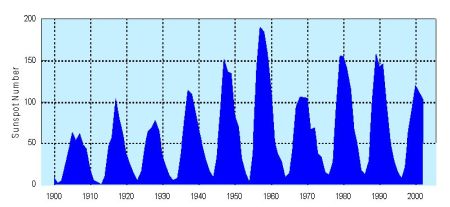
Annual mean sunspot numbers (1900 - 2002) (Source/Credits: National Geophysical Data Center, US Department of Commerce)
What are "sunspots"?
Sunspots are dark areas on the Sun's surface with relatively low temperatures (compared with other parts of the Sun) and strong magnetic fields. They normally appear in groups. The number of sunspots is usually taken as an indicator of solar activity. It increases significantly and can reach hundreds at the peak of a solar cycle.
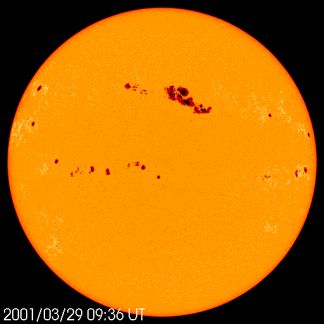
A huge sunspot group may cover an area 13 times or more the Earth's entire surface (Source/Credits: SOHO (ESA & NASA))
What is a "solar flare"?
Solar flare is a violent solar activity. Its occurrence is related to a sudden burst of electromagnetic waves and a vast amount of charged particles (mostly electrons) from the Sun. These electromagnetic waves can affect telecommunications, radio broadcast and navigation system on Earth. Sometimes, charged particles can also endanger the operations of spacecraft and satellites in space, and expose astronauts to higher amounts of radiation.
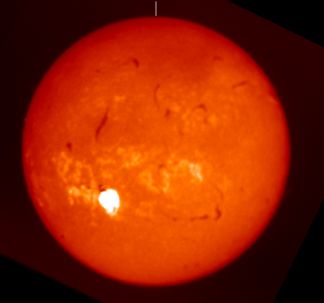
A solar flare (Source/Credits: Space Environment Center, Boulder, CO, National Oceanic and Atmospheric Administration, US Dept. of Commerce)
What is a "solar wind"?
The Sun releases tremendous energy. Solar wind refers to this released energy in the form of charged particles at high speed, reaching several hundred kilometres per second. While the magnetic field on the Earth (which traps charged particles encircling the Earth into radiation belts called the Van Allen belts) normally protects our planet from the solar wind, it may be deformed in the event of violent solar wind, resulting in a geomagnetic storm on Earth.
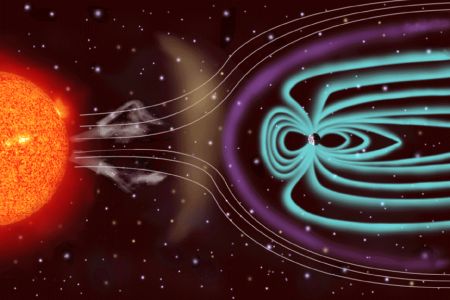
Illustration of the influence on the Earth's magnetic field when solar wind approaches the Earth. White lines represent the solar wind and the blue lines surrounding the Earth represent its magnetic field.(Source/Credits: SOHO (ESA & NASA))
What is a "geomagnetic storm"?
A geomagnetic storm occurs when a violent solar wind hits the Earth and severely distorts the Earth's magnetic field. Geomagnetic storms can seriously affect radio broadcasts and navigation systems, and paralyze electric grids on Earth. During the great geomagnetic storm in 1989, electricity was suspended for 9 hours in Quebec and a number of American satellites were taken out of service. The last significant geomagnetic storm occurred in October 2003 when intense solar flares erupted from the Sun. Among other incidents, the geomagnetic storm caused a Japanese communications satellite to shut down temporarily.
What are "auroras"?
Auroras are most commonly visible at high latitudes. They are associated with geomagnetic activity brought about by solar wind. Auroras occur as a result of charged particles (mostly electrons) from the Sun colliding with gas particles in the Earth's atmosphere, producing a glow in different colours. The patterns and shapes of the aurora are related to the flow of charged particles and the magnetic fields. In respect of the auroral colour, oxygen molecules produce green and red colours while nitrogen molecules produce purplish-red and blue colours.
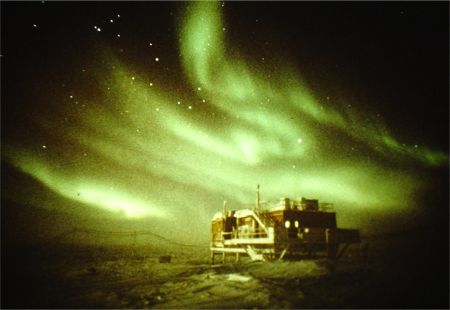
Picture of aurora taken at Antarctica (Source/Credits: John K.W. Chan, HKO)
How is space weather monitored?
As space weather originates from the Sun, it is monitored by international space weather centres using special satellites or telescopes. We will discuss more about this in the next issue.
Other related websites